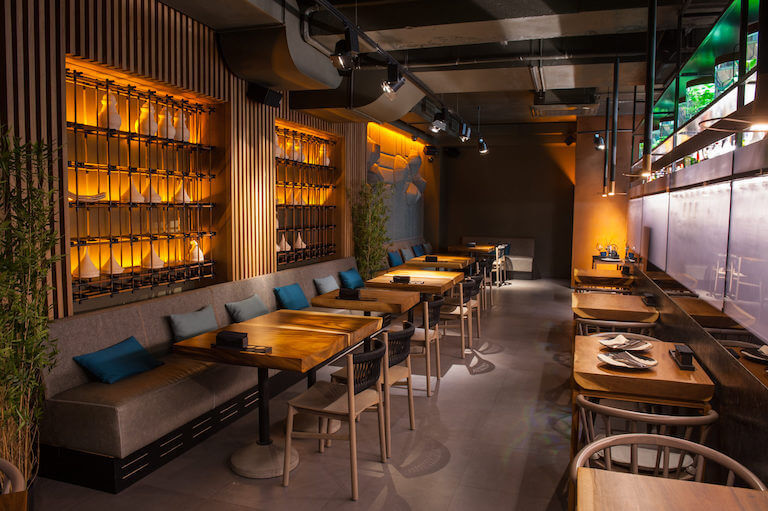Pan Asian Restaurant Islamabad: Discover Exquisite Asian Food
Pan Asian Restaurant Islamabad: Discover Exquisite Asian Food
Blog Article
Savor Genuine Asian Food With a Pan-Asian Twist for a Cooking Journey
Beginning on a culinary journey via genuine Oriental food, enhanced with a Pan-Asian twist, provides a distinct chance to explore the abundant tapestry of flavors that define the region's diverse culinary traditions. This experience welcomes you to savor the charming balance of preferences-- pleasant, salty, spicy, and sour-- integrated by aromatic natural herbs and spices. Visualize the ingenious blend of Thai curry and ramen or the unexpected delight of sushi burritos. As you contemplate these luring recipes, take into consideration the cultural stories and historical impacts that shape them, each bite providing a tale waiting to be found.

Checking Out Pan-Asian Tastes
In the world of international gastronomy, Pan-Asian cuisine stands apart for its remarkable variety and the harmonious interplay of flavors from numerous Asian cultures. This culinary approach celebrates the one-of-a-kind active ingredients and rich customs found across the continent, creating a tapestry of preferences that is both interesting and gratifying. Secret to Pan-Asian food is its capability to balance contrasting tastes-- wonderful, salty, spicy, and sour-- while highlighting the freshness and quality of each ingredient.
From the umami-rich soy sauce of Japan to the fiery chili peppers of Thailand, Pan-Asian cuisine offers an extensive scheme of tastes. These elements are frequently integrated in creative methods, enhancing dishes with layers of complexity. For example, the usage of fragrant natural herbs such as lemongrass and cilantro, typical in Vietnamese and Thai food, includes a refreshing illumination to meals, while the incorporation of coconut milk delivers a luscious, abundant structure.
The emphasis on fresh produce and aromatic spices guarantees that each meal is not just a feast for the taste however likewise for the senses. Pan-Asian cuisine welcomes restaurants to start a cooking trip, discovering the vast and varied landscapes of Asian gastronomy with every bite.
Combination Recipes to Attempt
While Pan-Asian cuisine is commemorated for its conventional flavors, the modern-day cooking landscape is significantly welcoming combination meals that mix these timeless aspects with influences from various other areas. This innovative approach not only honors the rich heritage of Eastern culinary arts yet also presents unique preference experiences that attract contemporary tastes buds.
An archetype of such a fusion dish is the Korean-Mexican taco, where marinated bulgogi beef is covered in a warm tortilla, covered with kimchi and a zesty gochujang-infused salsa. This mix marries the bold, full-flavored flavors of Korea with the dynamic, fresh aspects of Mexican cuisine. Likewise, sushi burritos have actually acquired popularity, joining together the fragile creativity of Japanese sushi with the hearty, hand-held convenience of a burrito, usually including blend ingredients like tempura shrimp and avocado with a drizzle of wasabi mayo.
Another notable recipe is Thai curry ramen, which instills the creamy, fragrant flavors of Thai curry into the soothing brew of conventional Japanese ramen, creating an unified mix that entices the detects. These fusion recipes expand past plain novelty; they represent a culinary discussion in between societies, urging exploration and innovation on the planet of Pan-Asian food.
Crucial Ingredients and Spices
To really appreciate Pan-Asian food, one should comprehend the vital ingredients and spices that create its structure. This diverse culinary style draws from a rich tapestry of Asian customs, utilizing a harmonious mix of structures and flavors.
Fragrant aspects are crucial, with lemongrass, ginger, and garlic being ubiquitous across various Pan-Asian recipes. These active ingredients provide an aromatic base that improves the complexity of tastes. Flavors such as celebrity anise, cardamom, and cinnamon present heat and character, resembling influences from areas like China and India.

Food Preparation Techniques and Tips
Understanding the art of Pan-Asian cuisine calls for familiarity with its unique cooking methods, each adding to the vivid tapestry of flavors this culinary custom is celebrated for. Central to these approaches is the stir-fry, a quick cooking method that protects the nutritional integrity and vibrant colors of components. Making use of a frying pan, the stir-fry approach enables even warmth circulation, important for attaining the particular appearance and taste equilibrium of Pan-Asian recipes.
Another essential method is steaming, especially widespread in Chinese food. This gentle technique maintains the natural tastes and nutrients of active ingredients, making it excellent for fish and shellfish and veggies. Dumplings, a cherished staple, frequently benefit from steaming, causing soft, delicious textures.
Barbecuing, additionally integral, gives smoky midsts to recipes such as Oriental bulgogi or Japanese yakitori (asian fusion restaurant). This technique usually includes marinating ingredients, allowing tastes to penetrate deeply before cooking over an open fire or warm plate
Lastly, grasping the art of stabilizing tastes-- wonderful, sour, salted, bitter, and umami-- is important. Properly layering these components can raise a recipe from ordinary to remarkable, using a complex and satisfying cooking experience that embodies the essence of Pan-Asian cuisine.
Dining Experiences Worldwide
Throughout the globe, Pan-Asian cuisine offers an exceptional dining experience, commemorated Instagrammable restaurants Islamabad for its rich tapestry of flavors and vibrant presentations. This cooking sensation has gone beyond social boundaries, recording the hearts and tastes buds of food enthusiasts worldwide. In multicultural cities fresh York, London, and Sydney, Pan-Asian dining establishments serve as fusions where culinary traditions from Thailand, Japan, China, and beyond converge, providing diners with an eclectic mix of recipes that highlight the region's diversity.
The international appeal of Pan-Asian food depends on its ability to offer both credibility and technology. Chefs skillfully wed conventional ingredients such as lemongrass, soy sauce, and miso with modern methods, resulting in recipes that are both refreshingly brand-new and acquainted. This blend enables diners to start a cooking trip that values heritage while embracing modernity.
In addition, dining experiences are raised with thoughtfully designed atmospheres that reflect the principles of Pan-Asian appearances. From minimalist Japanese-inspired insides to vivid Thai-themed spaces, each restaurant supplies a distinct setting that matches the cooking offerings. As an outcome, clients are not just taking in a dish yet partaking in a social experience, making Pan-Asian eating a truly worldwide phenomenon.
Conclusion
The expedition of Pan-Asian food provides a profound understanding of the complex interplay of flavors and culinary practices throughout Asia. By embracing combination recipes such as Thai curry ramen and sushi burritos, the cooking journey not just highlights the flexibility of typical ingredients but additionally showcases ingenious contemporary techniques. This gastronomic journey, enriched by essential flavors and cooking methods, supplies an one-of-a-kind possibility to value the cultural variety and culinary artistry that specify Pan-Asian cuisine on an international scale.
Embarking on a cooking trip via genuine Oriental food, enhanced with a Pan-Asian twist, offers a distinct opportunity to check out the rich tapestry of flavors that define the region's varied cooking traditions.In the realm of worldwide gastronomy, Pan-Asian food stands out for its amazing variety and the unified interplay of tastes from various Asian cultures. Key to Pan-Asian cuisine is its ability to stabilize contrasting tastes-- sweet, salted, spicy, and sour-- while highlighting the freshness and quality of each ingredient.

Report this page